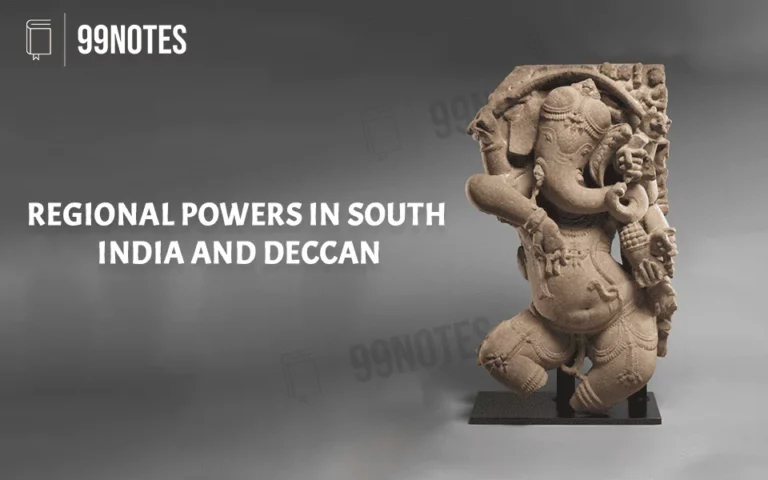Bahmani Kingdom and 5 Deccan Sultanates- Complete UPSC Notes
Bahmani Kingdom and Deccan Sultanates
After the fall of Yadavas and Kakatiyas to the Khaljis and Tughlaqs, several Muslim governorships were established in the region.
Mohamed Bin Tughalaq had made an elaborate administrative system for the Deccan region and, in the process, appointed Sada Amir/Amiran-i-sada,e. the chief of hundred villages. They performed both military and revenue functions.
However, during the later part of his reign, a series of revolts broke out in the Deccan region, after which he started the policy of their suppression. This lead to an even fierce revolt by the Amirs. This led to the establishment of the Bahmani Kingdom by Ala-ud-Din Bahman Shah (Jafar Khan) in 1347.
Bahmani Kingdom (1347-1525 CE)
The Bahmani Kingdom was spread over modern Karnataka, Maharashtra and Andhra Pradesh, with its capital at Ahsanabad (Gulbarga). They were in a constant tussle with the neighbouring Vijayanagar Empire.
Early Bahmani Kingdoms:
- Hasan Gangu/Jafar Khan, the founder of the Sultanate, adopted the title of Abu’l-Muzaffar Ala-ud-din Bahman Shah. His kingdom was divided into four tarafs(provinces)for efficient administration. The four provinces were Gulbarga, Daulatabad, Berar and Bidar.
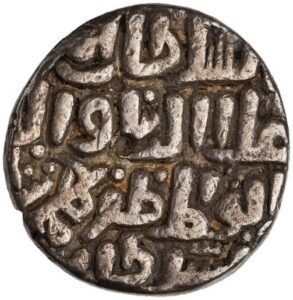
[Coin minted under Ala-ud-Din Bahman Shah]
- Mohammed Shah I (1358-1375CE), son of Allaudin Bahaman Shah, succeeded him. Throughout his reign, he was occupied in wars against Warangal and Vijayanagar.
- Alauddin Mujahid (1375-78): During his reign, a new factor was introduced in the composition of the nobility, i.e. the Afaqis (foreigners, mainly from Iraq and Iran).
- Taj ud-Din Firuz Shah/Firuz Shah Bahamani (1397 – 1422 CE): He expanded Bahmani kingdom and even succeeded in conquering the Raichur Doab from Vijaynagara kingdoms for some time.
- He wanted to make Deccan the cultural capital of India. He was well acquainted with religious texts and natural science like botany, geometry, logic etc.
- He inducted a large number of Hindus into his administration.
- In a peace treaty with the Vijayanagar Kingdom, the daughter of Deva Rai I was married off to him.
Mahmud Gawan (1466-1481)
Mahmud Gawan (1466-1481) was an Iranian merchant who came to India during the reign of Bahamani sultans. He was introduced to the Sultan and was well received; he was granted the title of Malik-ut-Tujjar.
Later he became the prime minister(Peshwa)during the reign of Muhammad Shah III and dominated the Bahmani kingdom for almost 20 years.
Expansion during Mahmud Gawan:
1. He expanded the Empire to its peak and conquered Kanchi, or Kanjeevaram, deep inside the Vijayanagar Empire. He also captured Goa and Dabhol, the economic centres of the Vijayanagar Empire.
2. He also fought successful wars against Konkan, Sangameshwara, and Orissa rulers.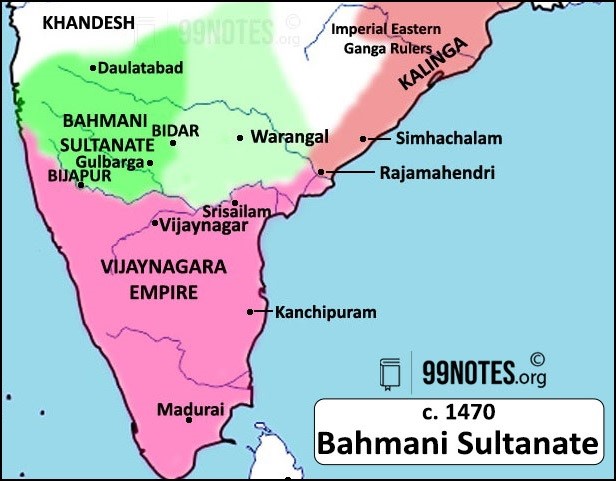
3. He also performed administrative reforms and divided the territory into eight tarafs under respective tarafdars.
4. He was an eminent patron of art and architecture and built a magnificent Madarasa in Persian style at the capital, Bidar.
5. Russian traveller Nikitin also came during this time. His famous book was The Journey beyond three seas.
6. He was executed in 1482 by the Sultan on account of false allegations made by native Nobels.
The 5 Deccan Sultanates
Soon after Gawan’s execution in 1482, the Bahmani kingdom weakened and was divided into 5 principalities/5 Deccan Sultanates:
1. Golconda
2. Bijapur
3. Ahmadnagar
4. Berar
5. Bidar
Apart from these, a much weaker Khandesh Sultanate too operated independently for some time. It was eventually brought into the Mughal domain by Akbar.
| 1. Nizamshahis of Ahmadnagar (1490-1633 CE)
|
|
| 2. Imad Shahis of Berar (1490-1574 CE) |
|
| 3. Qutub Shahis of Golconda (1518-1687 CE)
|
|
| 4. Adilshahis of Bijapur (1490-1686 CE)
|
|
| 5. Barid Shahis of Bidar (1528-1619 CE)
|
|
The decline of the Bahmani Sultanate
- The Bahmani kingdom followed a foreign policy of constant tussling with their neighbours like Vijayanagar and Warangal, significantly weakening the Empire.
- The internal tussle between Afaquis and Deccani nobles led to intrigues within the capital.
- The provincial governors acquired significant power, and with the weakening of the Sultanate, they claimed independence.
- There was no definite law of succession, which led to infighting among several claimants of the throne.
- Some of the rulers followed an extremely fanatical religious policy against their Hindu subjects, who formed the majority population of the kingdom.
Administration of Bahmani Kingdom
- The Bahamanis seem to have adopted the administrative system of the Delhi Sultanate.
- Bahmani kingdom was divided into Tarafs; initially, there were four tarafs. Each taraf was headed by a tarafdar. During Mahmud Gawan’s reign, as the Empire expanded, the kingdom was divided into eight tarafs.
- The nobility was divided into Afaqis or Pardesis (foreigners) and Deccanis (natives). Both sides were in a constant state of conflict.
- The commander of the army was known as Amir-Ul-Umara. The sultans also had a large number of bodyguards known as khassakhel.
Bahamani Society and culture
- The social character was cosmopolitan, and people of various ethnicities, like Hindus, Muslims, Iranians, Abyssinians, lived in the Bahmani kingdoms. Besides, several languages were widely used in the kingdom, such as Dakhani (proto-Urdu), Marathi, Kannada and Telugu.
- Dakhini was introduced by Ibrahim Adil shah in place of Persian as their
- Russian traveller Nikitin has mentioned the two classes; the nobles, who lived a lavish lifestyle and the general population, who were extremely poor.
- Bahamani ruler greatly venerated Sufis.
- There was a Shia influence in the Bahamani kingdom due to a significant influx of Afaqis (foreign, usually Irani nobles).
- Few rulers were intolerant towards Hindu traditions. For example, early Qutub Shahis of Golconda did not allow Hindus to profess their religion and observe festivals publically.
- Hindu traditions and culture also influenced the Bahmani court. For example, Sultan Feroz’s (1397-1422) marriage with the daughter of Deva Rai II of Vijaynagar strengthened the Hindu-Muslim cultural harmony.
Bahmani Kingdom Economy
- Mahmud Gawan undertook several reforms in land measurement, which led to an increase in the income of the kingdom.
- Trade and commerce were flourishing.
- Nikitin has mentioned trade activities in Bidar. He says the main trade items were horses, cloth, silk, and pepper. He mentioned Dabul as a centre of commercial activity. It provided connectivity with not only Indian but African ports as well.
- Trade and commerce were mainly in the hands of Hindu merchants.
Bahamani Art and Architecture
- Indo-Islamic architecture was prevalent, and the Persian style was a significant influence.
- Some of the essential structures of this era are:
Gol Gumbaz at Bijapur Source: https://en.wikipedia.org/wiki/Gol_Gumbaz
Bidri Art
- The famous Bidri Art developed around the 14th century during the Bahmani Sultanates.
- Bidri is a metal handicraft from the city of Bidar in south India. It uses blackened white brass, inlaid with silver, to produce its characteristic design.
- This technique is influenced by Persian art. It is said to have been brought by Sufi saint Khwaja Moinuddin Hasan Chisti in the form of utensils to India.
- This local art form has earned Geographical Indications Tags recently.

Conclusion
Bahmani Kingdom UPSC notes emphasize the dynasty’s contribution to Deccan architecture, culture, and the establishment of a distinct Islamic identity in South India, crucial for understanding the region’s historical evolution. The later rulers of the Bahmani Kingdom were too weak to carry out the Empire. Eventually, these were brought under the Mughal empire by Akbar and Aurangzeb. Nevertheless, the impact of Deccan-era Indo-Islamic art and traditions is still prominent in present-day India.

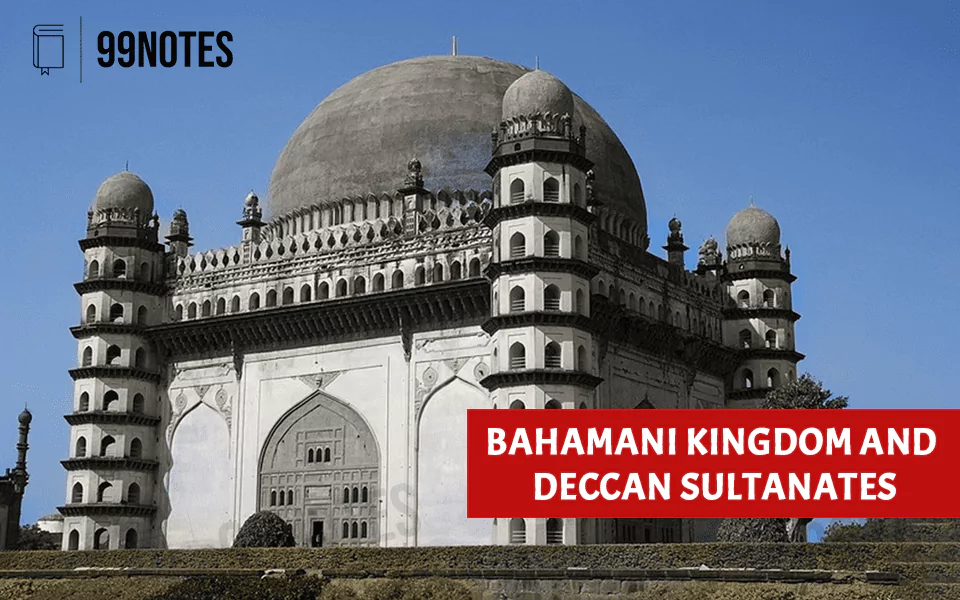
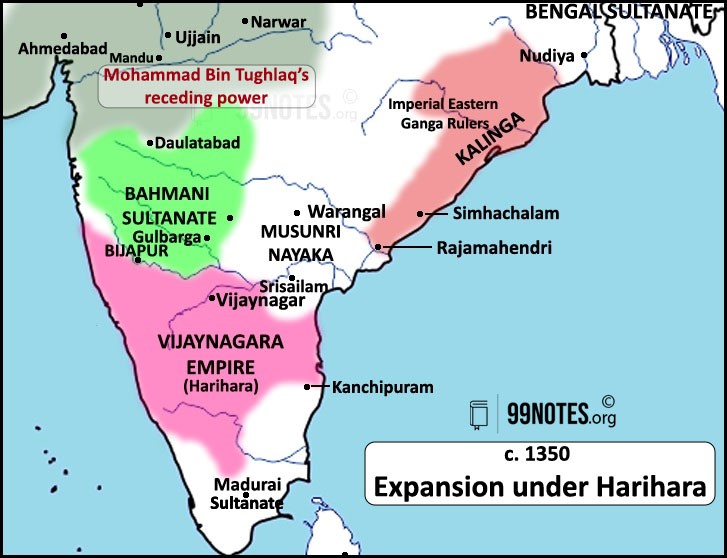


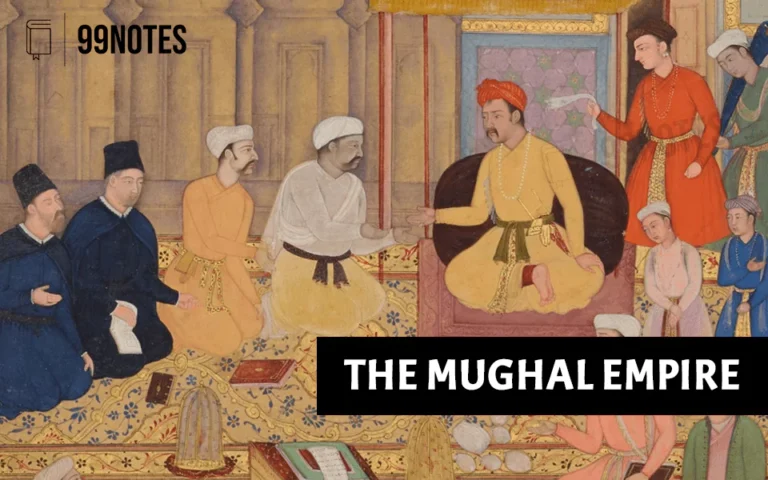

![Tripartite Struggle (790-1162Ad) History, Cause &Amp; Consequences [Upsc Notes] | Updated July 27, 2024 Tripartite Struggle (790-1162Ad) History, Cause & Consequences [Upsc Notes]](https://99notes.in/wp-content/uploads/2022/12/tripartite-struggle-featured-768x500.webp)

